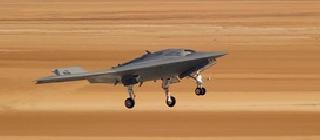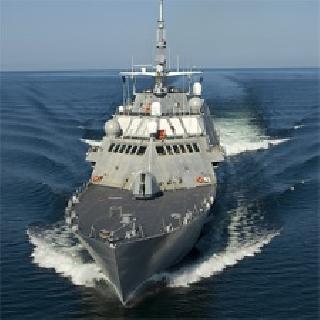
The US Navy's X-47B UCAS prepares to land at Edwards AFB. A Northrop Grumman photo
EDWARDS AIR FORCE BASE (BNS): Less than a month after completing the first flight of the US Navy's X-47B UCAS-Demonstration aircraft, flight test engineers from Northrop Grumman and the Navy have successfully completed the aircraft's second and third flights.
The flights, both conducted at Edwards Air Force Base, mark the beginning of a process called envelope expansion during which the test team will begin proving that the tailless aircraft can perform safely over a broad range of altitudes, air speeds and operating weights.
During the X-47B's 39-minute second flight on March 1, the aircraft flew to an altitude of 7,500 feet at speeds up to 200 knots. During its 41-minute third flight on March 4, the aircraft reached an altitude of 7,500 feet and a top speed of 180 knots. By comparison, the X-47B flew only to 5,000 feet at a top speed of 180 knots during its first flight February 4, a statement by Northrop Grumman said.
Phil Saunders, chief engineer for Northrop Grumman's Navy UCAS programme, said envelope expansion is designed to fully characterize the aircraft's flying qualities and prove that they match the system's performance requirements and the test team's predictions.
"Over the next few flights, we'll continue to expand the envelope in terms of air speed, altitude and operating weight range," he said.
Northrop Grumman and the Navy expect to complete the planned 49-flight envelope expansion program at Edwards Air Force Base before moving the first X-47B to Naval Air Station Patuxent River, Maryland, later this year, he added.
One of the most important measures of performance, Saunders explains, is aircraft stability. The X-47B, which relies on high-speed computers to manage its flight control surfaces, must be able to adjust quickly and automatically to unpredictable environmental conditions such as air turbulence or cross winds.
The recent test flights included a series of maneuvers designed to measure the aircraft's ability to maintain a smooth, level flying state in the presence of such conditions.
The flight tests also confirmed that the X-47B's flush mounted air data system – a nod to its low-observable-relevant design – is accurately sensing and communicating the aircraft's air speed, a critical factor in takeoff and landing.
The Navy awarded the UCAS-D prime contract to Northrop Grumman in August 2007. The six-year contract calls for the development of two X-47B fighter-sized aircraft.
The programme will demonstrate the first-ever carrier launches and recoveries by a tailless, unmanned aircraft. Autonomous aerial refueling will also be performed after carrier integration and at-sea trials.
 Previous Article
Previous Article Next Article
Next Article











The Indian Air Force, in its flight trials evaluation report submitted before the Defence Ministry l..
view articleAn insight into the Medium Multi-Role Combat Aircraft competition...
view articleSky enthusiasts can now spot the International Space Station (ISS) commanded by Indian-American astr..
view article